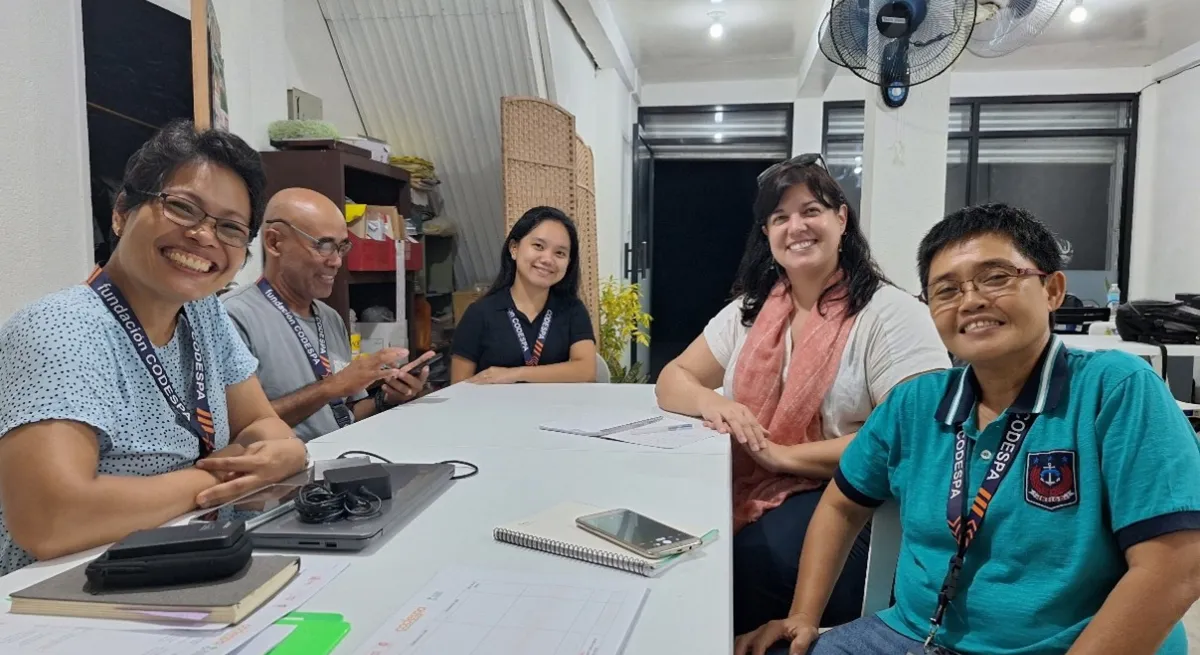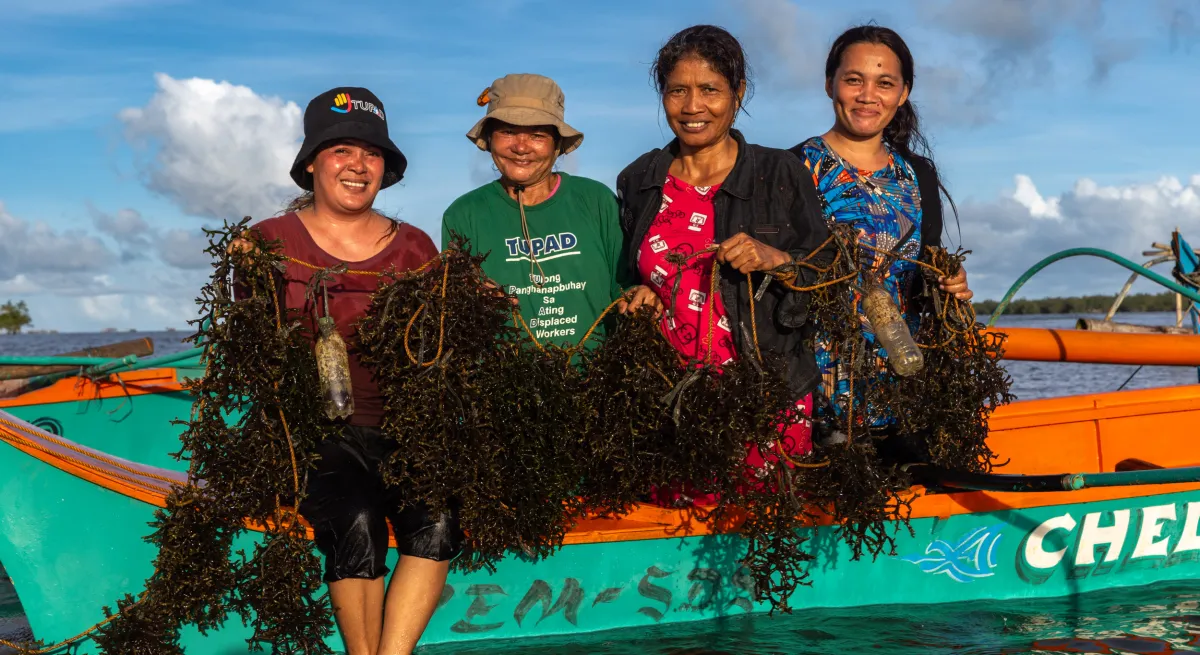Blanca Calleja is responsible for CODESPA's programs and projects in the Philippines, Ecuador, Guatemala and Nicaragua. Her responsibility is to support the team in each country with the presentation, development and evaluation of their initiatives.
She has celebrated one year at CODESPA, and her work is already yielding results. Recently, she traveled to the Philippines to see firsthand how Codespa's efforts are transforming lives of over 800 small seaweed farmers in the region.
For Blanca, this experience was emotional and productive in equal measure. CODESPA’s work is important, but people are even more so. Each team member and all the families they support have a unique story to tell. Today, Blanca shares hers with us.
Q:Blanca, you recently traveled to the Philippines, how did you experience it?
For me, seeing the impact on the communities we work with was the most important thing, and, of course, meeting the team was very enriching. Sharing ideas, comparing points of view, experiencing the reality of their day-to-day life, it's all much more fluid and has allowed me to better understand the work they do and the difficulties they face.
I have also come to understand the timing and processes involved in the implementation, monitoring, and reporting of projects. Carrying out the initiatives we propose is very difficult, there are many challenges. In addition to planning, they deal with many more variables: strikes, social and political situations and bad weather like storms or typhoons. And all this has to be identified, taken into account, and solutions must be found.
One of the things I enjoyed most was that, during the trip, I met with an external consultant. The reason for my trip was to visit a project that has been made possible thanks to the support of the Julius Baer Foundation.
Together, we are strengthening small seaweed farmers in a coastal area in the south of the country called Hinatuan. The conditions there are very favourable for growing high-quality seaweed, which is in high demand in the market, but their situation prevented them from accessing the market under fair conditions; they are very vulnerable. The consultant was preparing a market study to expand the scope of the project. It was very interesting, as we shared points of view that will improve the goals achieved and facilitate the collection of information to prepare the final reports. In addition, the consultant interacted directly with our local team and other key stakeholders, such as the community, businesses and universities, generating valuable feedback in real time.
"Together, we are strengthening small seaweed farmers in a coastal area in the south of the country called Hinatuan."
What are the objectives of these consultancies and how do they contribute to CODESPA?
A fundamental part of the CODE Method, which is the way we work, is the exit strategy. The success of this project lies in the fact that CODESPA has connected the Spanish seaweed processing company, CEAMSA, with the Hinatuan Seaweed Producers Association (HSWPA). This connection allows families to obtain better prices for their seaweed than those offered by local middlemen.
Thanks to this relationship, CEAMSA understands the difficulties and context of the local communities, while HSWPA farmers have learnt about CEAMSA's quality standards and needs. This has generated a relationship of trust that has resulted in the signing of a contract. The farmers now deliver such high quality seaweed that CEAMSA can process it quickly, to the benefit of both parties.
As it is our mission to elevate people from poverty to prosperity by their own means, CODESPA supports HSWPA to diversify its client portfolio and thus guarantee the medium- and long-term sustainability of the association. The market studies we are conducting seek to identify other potential clients to diversify opportunities for the farmers and cooperatives we support, ensuring win-win business relationships.
The consultant with whom I met during my trip was analysing different niche markets for seaweed. Among the most promising are the production of biofertilizers, ready-to-eat foods, snacks and other derivatives with high income potential for communities. The objective is to prioritize those niches with the greatest impact and viability in the short and medium term.

Is that what the exit strategy you were talking about means?
That’s right. In cooperation, sustainability is key as many funders want to know how the project will be sustained once we withdraw. At CODESPA, we incorporate this strategy as one of the key outcomes of our activities.
We achieve this through alliances, commercial networks, market studies and participation in fairs. We not only prepare entrepreneurs, cooperatives and microenterprises to place their products, but we also accompany them until the final sale. As in the case of seaweed, we are now integrating new farmers and looking for more clients to expand the project. We always seek to ensure the long-term viability of our initiatives.
Of everything you learnt on your trip, what surprised you the most?
We talk a lot about this project, so what I liked the most was to witness the transformation that the community is experiencing. And I was very curious to see the whole process of seaweed cultivation, which I was completely unaware of.
Can you tell us about it?
Of course! I had the opportunity to see several phases of this process.
First, very importantly, the seaweed to be cultivated has to be selected. This seaweed is from previous cultivations where the best 20% of the total amount harvested is reserved for replanting.
The first phase is carried out on land, where on a rope of about 100 m long, these seaweed shoots are tied and planted at a depth of about 20 cm.
A few days later, they are placed on new ropes to carry the seaweed to the sea. These ropes are tied to plastic bottles so that they do not sink. Although the bottles are reused, hopefully we can find another solution soon that does not involve plastics. The seaweed takes between 45-60 days to grow depending, for example, on the water temperature which varies between the dry season and the rainy season. When the seaweed has grown to 50-80 cm then it’s time to harvest and the farmers gather it from their boats.

Harvesting, which consists of pulling the rope out of the water, is mainly done by men because of the weight. Each 100-meter length of rope can weigh up to 300 kg. Upstream, all family members participate in the preparation and sometimes other farmers are hired from outside HSWPA, who are paid for their work. Both men and women participate in planting, but harvesting is mostly done by men due to the physical demands.
After collection, the seaweed is taken to structures called dryers, which have been donated by the local governments. The day I visited the community it was raining, so I could not see them working, but the seaweed is dried there for a few days and then weighed, packed and sent to CEAMSA.
CEAMSA pays 80% of the price in advance, thanks to the trust that has already been built, which is the key to this project. Farmers are responsive and this has made payment much faster. This keeps them motivated.
The price per kilo reaches 60 Philippine pesos, but at times it has reached 150 pesos, in other words, as for other raw materials like coffee or cocoa, the price of seaweed varies. This is because sometimes there is more production, sometimes less. For example, a few months ago, there was a typhoon that caused the loss of a large quantity of the planted seaweed and the price skyrocketed. With these calculations, a family can earn an average of 300-400€, which for these communities is a very positive income compared to what they used to get before, because they are selling directly to the company.
I was able to see the real impact our projects have on people. We read too many reports, analyses ... and travelling there, you realise who we work for and understand the effort. A picture is worth 1,000 words, they say, well, for me a day in the community is worth more than 1,000 reports.
At the time of this interview, we did not yet have this good news, but now we can share that in 2024, HSWPA has changed from an association to a cooperative in order to receive credits. It is now called: Hinatuan Seaweed and Fisherman Company (HISFA-CO). Congratulations!
Source: Codespa
Did you enjoy this exchange?
If you are a researcher or specialist in inequality reduction issues, write to us and let's talk.
